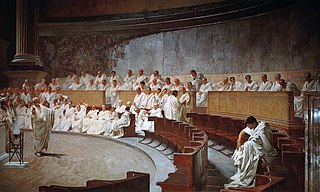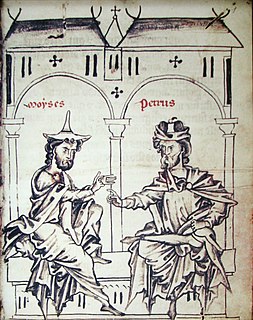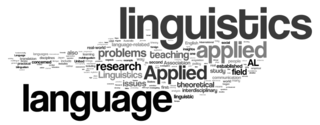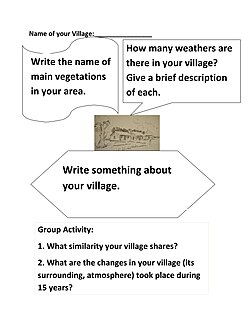
Epistemology is the branch of philosophy concerned with the theory of knowledge.

Public speaking is the process or act of performing a speech to a live audience. Public speaking is commonly understood as formal, face-to-face speaking of a single person to a group of listeners. Traditionally, public speaking was considered to be a part of the art of persuasion. The act can accomplish particular purposes including to inform, to persuade, and to entertain. Additionally, differing methods, structures, and rules can be utilized according to the speaking situation.

The Tractatus Logico-Philosophicus is the only book-length philosophical work by the Austrian philosopher Ludwig Wittgenstein that was published during his lifetime. The project had a broad goal: to identify the relationship between language and reality and to define the limits of science. It is recognized by philosophers as a significant philosophical work of the twentieth century. G. E. Moore originally suggested the work's Latin title as homage to the Tractatus Theologico-Politicus by Baruch Spinoza.

The Socratic method, also known as method of Elenchus, elenctic method, or Socratic debate, is a form of cooperative argumentative dialogue between individuals, based on asking and answering questions to stimulate critical thinking and to draw out ideas and underlying presuppositions. It is a dialectical method, involving a discussion in which the defense of one point of view is questioned; one participant may lead another to contradict themselves in some way, thus weakening the defender's point. This method is named after the Classical Greek philosopher Socrates and is introduced by him in Plato's Theaetetus as midwifery (maieutics) because it is employed to bring out definitions implicit in the interlocutors' beliefs, or to help them further their understanding.

In spoken language analysis, an utterance is the smallest unit of speech. It is a continuous piece of speech beginning and ending with a clear pause. In the case of oral languages, it is generally, but not always, bounded by silence. Utterances do not exist in written language, however, only their representations do. They can be represented and delineated in written language in many ways.

Debate is a process that involves formal discussion on a particular topic. In a debate, opposing arguments are put forward to argue for opposing viewpoints. Debate occurs in public meetings, academic institutions, and legislative assemblies. It is a formal type of discussion, often with a moderator and an audience, in addition to the debate participants.
Conversation analysis (CA) is an approach to the study of social interaction, embracing both verbal and non-verbal conduct, in situations of everyday life. CA began with a focus on casual conversation, but its methods were subsequently adapted to embrace more task- and institution-centered interactions, such as those occurring in doctors' offices, courts, law enforcement, helplines, educational settings, and the mass media. As a consequence, the term 'conversation analysis' has become something of a misnomer, but it has continued as a term for a distinctive and successful approach to the analysis of sociolinguistic interactions.

Forensic linguistics, legal linguistics, or language and the law, is the application of linguistic knowledge, methods and insights to the forensic context of law, language, crime investigation, trial, and judicial procedure. It is a branch of applied linguistics.

An audience is a group of people who participate in a show or encounter a work of art, literature, theatre, music, video games, or academics in any medium. Audience members participate in different ways in different kinds of art; some events invite overt audience participation and others allowing only modest clapping and criticism and reception.
Discourse analysis (DA), or discourse studies, is an approach to the analysis of written, vocal, or sign language use, or any significant semiotic event.
In social science generally and linguistics specifically, the cooperative principle describes how people achieve effective conversational communication in common social situations—that is, how listeners and speakers act cooperatively and mutually accept one another to be understood in a particular way. As phrased by Paul Grice, who introduced it in his pragmatic theory,
Make your contribution such as is required, at the stage at which it occurs, by the accepted purpose or direction of the talk exchange in which you are engaged.

Communicative rationality or communicative reason is a theory or set of theories which describes human rationality as a necessary outcome of successful communication. In particular, it is tied to the philosophy of German philosophers Karl-Otto Apel and Jürgen Habermas, and their program of universal pragmatics, along with its related theories such as those on discourse ethics and rational reconstruction. This view of reason is concerned with clarifying the norms and procedures by which agreement can be reached, and is therefore a view of reason as a form of public justification.
In linguistics, modality is a system of linguistic options that allows for expressing a speaker's general intentions as well as the speaker's belief as to whether the proposition expressed is true, obligatory, desirable, or actual. Modal options can be realized by word order (moods), modal auxiliaries and modal adjuncts.
The Form of Preaching is a 14th-century style book or manual about a preaching style known as the "thematic sermon", or "university-style sermon", by Robert of Basevorn. Basevorn’s text was not the first book about this topic to appear but was popular because it is very thorough.
The term linguistic performance was used by Noam Chomsky in 1960 to describe "the actual use of language in concrete situations". It is used to describe both the production, sometimes called parole, as well as the comprehension of language. Performance is defined in opposition to "competence"; the latter describes the mental knowledge that a speaker or listener has of language.
Language teaching, like other educational activities, may employ specialized vocabulary and word use. This list is a glossary for English language learning and teaching using the communicative approach.

In systemic functional grammar, a thematic equative is a thematic resource in which two or more separate elements in a clause are grouped together to form a single constituent of the theme-plus-rheme structure. An example of this is:

Thematic teaching is the selecting and highlighting of a theme through an instructional unit or module, course, multiple courses. It is often interdisciplinary, highlighting the relationship of knowledge across academic disciplines and everyday life. Themes can be topics or take the form of overarching questions. Thematic learning is closely related to interdisciplinary or integrated instruction, topic-, project- or phenomenon-based learning. Thematic teaching is commonly associated with elementary classrooms and middle schools using a team-based approach, but this pedagogy is equally relevant in secondary schools and with adult learners. Thematic instruction assumes students learn best when they can associate new information holistically with across the entire curriculum and with their own lives, experiences, and communities.
Thematic analysis is one of the most common forms of analysis within qualitative research. It emphasizes identifying, analysing and interpreting patterns of meaning within qualitative data. Thematic analysis is often understood as a method or technique in contrast to most other qualitative analytic approaches - such as grounded theory, discourse analysis, narrative analysis and interpretative phenomenological analysis - which can be described as methodologies or theoretically informed frameworks for research. Thematic analysis is best thought of as an umbrella term for a variety of different approaches, rather than a singular method. Different versions of thematic analysis are underpinned by different philosophical and conceptual assumptions and are divergent in terms of procedure. Leading thematic analysis proponents, psychologists Virginia Braun and Victoria Clarke distinguish between three main types of thematic analysis: coding reliability approaches, code book approaches and reflexive approaches. They describe their own widely used approach first outlined in 2006 in the journal Qualitative Research in Psychology as reflexive thematic analysis. Their 2006 paper has over 59,000 Google Scholar citations and according to Google Scholar is the most cited academic paper published in 2006. The popularity of this paper exemplifies the growing interest in thematic analysis as a distinct method.
Personal narrative (PN) is a prose narrative relating personal experience usually told in first person; its content is nontraditional. "Personal" refers to a story from one's life or experiences. "Nontraditional" refers to literature that does not fit the typical criteria of a narrative.












